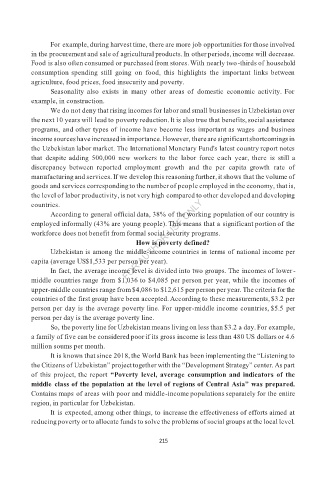Page 218 - Theoretical and Practical Interpretation of Investment Attractiveness
P. 218
For example, during harvest time, there are more job opportunities for those involved
in the procurement and sale of agricultural products. In other periods, income will decrease.
Food is also often consumed or purchased from stores. With nearly two-thirds of household
consumption spending still going on food, this highlights the important links between
agriculture, food prices, food insecurity and poverty.
Seasonality also exists in many other areas of domestic economic activity. For
example, in construction.
We do not deny that rising incomes for labor and small businesses in Uzbekistan over
the next 10 years will lead to poverty reduction. It is also true that benefits, social assistance
programs, and other types of income have become less important as wages and business
income sources have increased in importance. However, there are significant shortcomings in
the Uzbekistan labor market. The International Monetary Fund's latest country report notes
that despite adding 500,000 new workers to the labor force each year, there is still a
discrepancy between reported employment growth and the per capita growth rate of
manufacturing and services. If we develop this reasoning further, it shows that the volume of
goods and services corresponding to the number of people employed in the economy, that is,
the level of labor productivity, is not very high compared to other developed and developing
countries.
According to general official data, 38% of the working population of our country is
employed informally (43% are young people). This means that a significant portion of the
workforce does not benefit from formal social security programs.
How is poverty defined?
Uzbekistan is among the middle-income countries in terms of national income per
capita (average US$1,533 per person per year).
In fact, the average income level is divided into two groups. The incomes of lower-
middle countries range from $1,036 to $4,085 per person per year, while the incomes of
upper-middle countries range from $4,086 to $12,615 per person per year. The criteria for the
countries of the first group have been accepted. According to these measurements, $3.2 per
person per day is the average poverty line. For upper-middle income countries, $5.5 per
person per day is the average poverty line.
So, the poverty line for Uzbekistan means living on less than $3.2 a day. For example,
a family of five can be considered poor if its gross income is less than 480 US dollars or 4.6
million soums per month.
It is known that since 2018, the World Bank has been implementing the “Listening to
the Citizens of Uzbekistan” project together with the “Development Strategy” center. As part
of this project, the report “Poverty level, average consumption and indicators of the
middle class of the population at the level of regions of Central Asia” was prepared.
Contains maps of areas with poor and middle-income populations separately for the entire
region, in particular for Uzbekistan.
It is expected, among other things, to increase the effectiveness of efforts aimed at
reducing poverty or to allocate funds to solve the problems of social groups at the local level.
215

